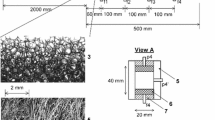Abstract
Experiments were carried out to investigate the combustion propagation phenomenon in a horizontal channel partially filled with ceramic-oxide spherical beads. A 1.22 m long, 43 mm nominally thick layer of spherical beads is located at the ignition end of a 2.44 m long, 76 mm square channel. Tests were performed with 6.4 and 12.7 mm diameter beads. A flame is ignited at the bead end wall by an automotive spark ignition system. Flame propagation and pressure measurements are obtained via ionization probes and piezoelectric pressure transducers mounted on the top and bottom surfaces of the channel. High-speed schlieren video was used to visualize the structure of the explosion front. Experiments were performed with a 31% nitrogen diluted stoichiometric methane–oxygen mixture at room temperature and at an initial pressure in the range of 15–50 kPa. For initial pressures of 15 and 20 kPa the flame accelerates to a velocity close to the speed of sound in the combustion products. For initial pressure of 30 kPa and higher DDT occurs in the gap above the bead layer. An explosion front propagating at a velocity just under the CJ detonation velocity is detected in the bead layer even though the bead layer pore size is much smaller than the detonation cell size. It is demonstrated that flame propagation within the bead layer is the driving force behind the very rapid flame acceleration observed, however the DDT event occurring in the gap above the bead layer is not affected by the bead layer porosity. Schlieren video indicates that the structure of the explosion front varies across the channel height and with propagation distance down the channel.
Similar content being viewed by others
References
Babkin, V.S.: The problems of porous flame-arresters, prevention of hazardous fires and explosions. In: Zarko, V.E. et al. (eds.), Kluwer, Netherlands, pp. 199–213 (1990)
Joo P., Duncan K. and Ciccarelli G. (2006). Flame quenching performance of ceramic foam. Combust. Sci. Technol. 178(10–11): 1755 doi:10.1080/00102200600788692
Hlouschko, S., Ciccarelli, G.: In: Proceedings of the 21st international colloquium on the dynamics of explosions and reactive systems, Futuroscope, France (2007)
Babkin V.S., Korzhavin A.A. and Bunev V.A. (1991). Propagation of premixed gaseous explosion flames in porous media. Combust. Flame doi:10.1016/0010-2180(91)90168-B
Pinaev A.V. (1994). Combustion modes and flame propagation criteria for an encumbered space. Combust. Explos. Shock Waves 30(4): 454–461 doi:10.1007/BF00790150
Makris A., Shafique H., Lee J.H. and Knystautas R. (1995). Influence of mixture sensitivity and pore size on detonation velocities in porous media. Shock Waves 5: 589–595 doi:10.1007/BF02425039
Peraldi O., Knystautas R. and Lee J.H. (1986). Criteria for transition to detonation in tubes. Proc. Combust. Inst. 21: 1629–1637
Mihalik, T.A., Lee, J.H., Continillo, G., Marra, F.S.: Quenching mechanisms of gaseous hydrocarbon–air flames in packed beds. In: Proceedings of the 18th international colloquium on the dynamics of explosions and reactive systems, Seattle, US (2001)
Pantow E.G., Fischer M. and Kratzel T. (1996). Decoupling and recoupling of detonation waves associated with sudden expansion. Shock Waves 6: 131–137 doi:10.1007/BF02510993
Thomas, G.O., Sands, C.J., Brambrey, R.J., Jones, S.A.: Experimental observations of the onset of turbulent combustion following shock-flame interaction. In: Proceedings of the 16th international colloquium on the dynamics of explosions and reactive systems, Cracow, Poland (1997)
Khokhlov A.M., Oran E.S. and Thomas G.O. (1999). Numerical simulation of deflagration-to-detonation transition: the role of shock–flame interactions in turbulent flames. Combust. Flame 117: 323–339 doi: 10.1016/S0010-2180(98)00076-5
Kuznetsov, M., Matsukov, I., Alekseev, V., Breitung, W., Dorofeev, S.: Proceedings of the 20th international colloquium on the dynamics of explosions and reactive systems, Montreal, Canada (2005)
Author information
Authors and Affiliations
Corresponding author
Additional information
Communicated by E. Timofeev.
This paper is based on the work presented at the 26th internationl symposium on shock waves. Göttingen, Germany, July 15–20, 2007.
Rights and permissions
About this article
Cite this article
Johansen, C., Ciccarelli, G. Combustion in a horizontal channel partially filled with a porous media. Shock Waves 18, 97–106 (2008). https://doi.org/10.1007/s00193-008-0151-0
Received:
Accepted:
Published:
Issue Date:
DOI: https://doi.org/10.1007/s00193-008-0151-0




